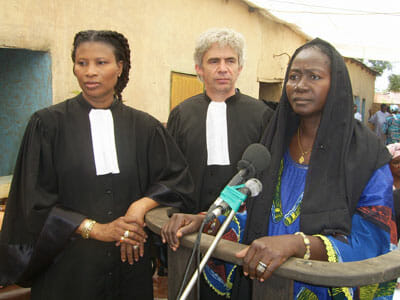
DVD Release Date: April 15
Original Theatrical Release Date: February 14, 2007
Director: Abderrahmane Sissako
Writer: Abderrahmane Sissako
Cinematographer: Jacques Besse
Starring: Aïssa Maïga, Tiécoura Traoré, Hélène Diarra, Habib Dembélé
Studio/Run Time: New Yorker Films, 115 mins.
Abderrahmane Sissako’s Life on Earth (1998) begins in a modern French supermarket. An African man shops for a few moments and then steps onto an escalator. Sissako’s camera looks down the stairway as the man ascends, and then the film cuts to what seems like the reverse shot, the man’s point of view as he looks toward the top, but what we see is not the upper level of the store but a treetop. The camera continues climbing toward the tree as if it’s on an escalator, but clearly the movie—like the man’s thoughts—has gone elsewhere. It’s gone to Mali, it turns out, where it stays for the duration of film.
In that one elegant but abrupt action, Sissako connects two worlds—urban France and rural Mali—by mentally joining their spaces into one, and in his latest film, the remarkable Bamako, he sustains a similar effect for the movie’s entire length.
Bamako revolves around a trial, but it’s a most unusual courtroom drama. On trial are the Western institutions, like the World Bank and the IMF, that have pressed their policies onto Africa. It’s a fantasy, of course, that the Western world could be asked to defend its actions in a trial complete with black-robed prosecutors and defendants who state their cases to a panel of judges. However, it’s not a one-sided affair. The arguments are as complex as they are impassioned.
But Sissako’s bolt of lightning is how he once again merges spaces: he sets the trial out-of-doors, in an unassuming courtyard in Mali. Looking on, fanning themselves in the heat, are villagers who live nearby, farmers and authors, some of whom testify about life in their part of the world. Sissako has an aesthetician’s eye for color and rhythm, editing the village’s daily events—the kids playing, the textile makers weaving and dying their cloth—as if they are all a part of the trial’s fabric. Every day as the proceedings are about to get underway, as people file into the rows of folding chairs and the lawyers and cameramen take their places, a cheerfully attired nightclub singer crosses the courtyard to ask for help zipping up her dress. She lives here. This is her space, too.
Outside of the trial, the village has its own drama, though it’s so quiet that it’s easy to miss. A marriage is breaking up. People are trying to work. They’re interested in the trial, but life goes on. Sissako’s setting is not only a beautiful sight to behold, but it’s also a social statement, since much of what has been done to and for Africa is decided on other continents or reflected through the lenses and deeds of Westerners, whether they’re well-meaning or opportunistic. In the fantasy of Bamako, the voices of the effected speak in a familiar locale where the residents get not only their say but their portion of the blame. Bamako is a serious but pragmatic view of justice, an earthy, graspable look at world-shaking economic policies, a weighty tapestry of whimsical colors.